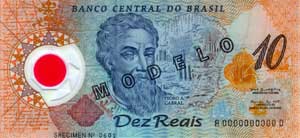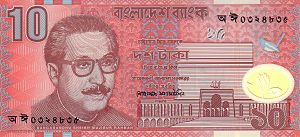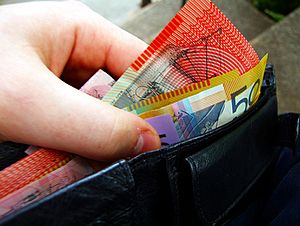Polymer banknote facts for kids
Polymer banknotes are special money notes made from polymer (plastic). They were first created in Australia in 1988 by the Reserve Bank of Australia, CSIRO, and the University of Melbourne. These plastic notes last much longer than paper money because they don't rip or tear easily. They are also much harder for people to copy.
Many countries around the world now use polymer banknotes. Seven countries have even switched all their money notes from paper to plastic. Even though they cost twice as much to make, they last four times longer than paper notes. Polymer notes are great for places with high humidity or wet weather, as they don't get damaged when they get wet.
Contents
How Polymer Banknotes Started
In 1967, fake Australian $10 notes started appearing. The Reserve Bank of Australia worried about more fake money because new color photocopiers were becoming available. To fight this, experts began working on new ways to make money safer.
In 1972, someone suggested adding a special security feature made of plastic. This feature would change how it looked when you tilted the note. The first patent for polymer banknotes was filed in 1973. Later, a method called lamination was used to put different materials together. They chose a clear plastic material that could hold the security features.
Other types of plastic money were also tried. In the early 1980s, a company called American Bank Note Company used a plastic called Tyvek. But these notes didn't work well; the ink would smudge, and they were fragile. Only Costa Rica and Haiti used Tyvek notes for a short time.
Another plastic material called DuraNote was developed in the 1980s. The Bank of Canada and the United States Department of the Treasury tested it. Many other countries also looked into using it.
How Polymer Banknotes Are Made
Polymer banknotes were developed in Australia to create money that was safer and lasted longer than paper notes.
The plastic material used is called BOPP. It goes through several steps:
- Making it Opaque: Two layers of ink are put on each side of the note. This makes it solid, except for any clear parts.
- Cutting into Sheets: Large rolls of the plastic are cut into smaller sheets for printing.
- Printing: Special printing methods are used to add the designs and details.
- Adding a Protective Layer: The notes are covered with a protective varnish to make them even more durable.
BOPP plastic is smooth and doesn't have fibers or pores like paper. This makes polymer banknotes much better than paper ones because they are:
- Harder to tear.
- More resistant to folding.
- Cleaner and don't get dirty as easily.
- Waterproof, even in a washing machine!
- Harder to burn.
- Easier for machines to count and sort.
- Recyclable at the end of their life.
Security Features

Polymer banknotes have different levels of security to prevent fakes.
- Easy-to-Spot Features: These are things you can easily see or feel. They include raised printing, metal strips, and clear windows in the note.
- Machine-Readable Features: These features can only be detected by special machines.
- Expert-Only Features: Some security features can only be checked by the bank that issued the money.
Countries Using Polymer Banknotes

Modern polymer banknotes were first used in Australia in 1988. This was to celebrate Australia's 200th birthday. Note Printing Australia, a company owned by Australia's central bank, prints these notes. They have printed money for over 20 countries.
As of 2014, at least seven countries had fully switched to polymer banknotes:
Many other countries and regions also use some polymer notes. These include Bangladesh, Brazil, Chile, Hong Kong, Indonesia, Israel, Malaysia, Mexico, Singapore, Sri Lanka, Thailand, and Zambia. Canada started using its first polymer banknote ($100) in 2011. By 2013, all of Canada's banknotes were polymer.
In 2012, Nigeria tried to switch back to paper notes, saying polymer notes were hard to handle. However, their president stopped this plan.
In the United Kingdom, the first polymer banknotes were issued in Northern Ireland in 2000. These were special notes. In 2015, Scotland started using polymer £5 notes. The Bank of England began issuing polymer £5 notes in 2016, followed by £10 notes in 2017. They plan to change the £20 and £50 notes to polymer too.
Timeline of Adoptions
1980s
- 1982-1983: Costa Rica and Haiti issued notes on DuPont's Tyvek plastic. These notes had problems with ink smudging in hot climates.
- 1983: The Isle of Man issued a 1-pound note on a plastic called Bradvek.
- 1988: Australia issued its first polymer banknote, a special 10-dollar note.
1990s
- 1990: Samoa issued a 2 Tala polymer note. It has been in use for a very long time.
- 1991: Papua New Guinea issued its first polymer note, a 2 Kina.
- 1992: Australia began using a full set of polymer notes for everyday use.
- 1993: Kuwait issued a special 1 Dinar polymer note. Indonesia also issued its first polymer note, a 50,000 rupiah.
- 1996: Australia became the first country to have all its banknotes (from 5 to 100 dollars) made of polymer. Brunei also started issuing regular polymer notes.
- 1997: Thailand issued its first polymer note for general use, a 50 baht note.
- 1999: New Zealand started switching all its notes to polymer, completing the change by 2000. Romania became the first European country to use a full set of polymer banknotes.
2000s
- 2000: Brazil released a 10 real polymer note to celebrate 500 years since Europeans arrived. Bangladesh issued 10-Taka polymer notes.
- 2001: Australia issued a special $5 polymer note.
- 2002: Nepal issued a 10 rupee polymer note. Mexico switched its 20-pesos banknote to polymer.
- 2003: Zambia became the first African country to use polymer notes. Vietnam began switching all its notes to polymer, finishing by 2006.
- 2004: Chile started issuing 2000 peso polymer notes. Malaysia introduced a 5 ringgit polymer note.
- 2005: Papua New Guinea issued its first 100 kina note, which was only ever printed on polymer.
- 2007: Nigeria issued a 20 naira polymer note. Hong Kong started a two-year trial with a 10-dollar polymer note. Brunei became the fifth country to fully switch to polymer notes.
- 2008: Israel started issuing 20 ILS polymer notes. Papua New Guinea completed its switch to polymer for all denominations.
- 2009: Nicaragua released new polymer 10 and 20 córdoba notes. Chile began a new series of polymer notes.
2010s
- 2010: The Dominican Republic introduced a new 20 pesos polymer bill. Vanuatu issued a 10,000 vatu polymer note.
- 2011: Mozambique began printing some notes on polymer. Canada introduced its first polymer banknote, the $100 note.
- 2012: Malaysia issued new RM1 and RM5 polymer banknotes.
- 2013: Fiji introduced a new $5 polymer note. Mauritius issued new 25-, 50-, and 500-rupee polymer notes. The Bank of England announced it would adopt polymer notes.
- 2014: Vanuatu introduced more polymer notes. Poland issued a special 20 złotych polymer note. Cape Verde issued a 200 escudos polymer banknote.
- 2015: New Zealand introduced a new family of polymer notes. Clydesdale Bank and Royal Bank of Scotland in the UK issued polymer £5 notes. The Maldives introduced a new family of polymer banknotes. Singapore issued special polymer notes for its 50th anniversary.
- 2016: Gibraltar issued a 100-pounds sterling polymer note. Australia issued a new A$5 polymer note with better security. The Bank of England began issuing the new polymer £5 note in England and Wales.
- 2017: North Macedonia issued 10 and 50 denari polymer notes. The Bank of Canada unveiled a $10 polymer note for Canada's 150th anniversary. The Bank of England issued a new polymer £10 note. Vanuatu completed its family of polymer banknotes. Mauritania announced a new series of all-polymer banknotes for 2018.
- 2018: North Macedonia issued more polymer notes. Russia issued a 100 rubles polymer note for the World Cup. The Solomon Islands issued a SI$40 polymer note. The Eastern Caribbean Central Bank announced new vertical polymer notes for 2019. Uruguay issued a 50 pesos polymer note. Australia issued a new A$50 polymer banknote. Canada issued a new C$10 polymer banknote featuring Viola Desmond. Romania issued a 100 lei polymer note. Mauritius issued a 2,000-rupees polymer note.
- 2019: Libya issued a 1 Libyan Dinar polymer note. Banks in Northern Ireland issued new polymer banknotes. The Solomon Islands issued a SI$5 polymer note. Samoa issued a 10 tālā polymer note. Morocco issued a 20-dirhams polymer note.
Images for kids
-
Banknote of 200 escudos, made of polymer
See also
 In Spanish: Billete de polímero para niños
In Spanish: Billete de polímero para niños




